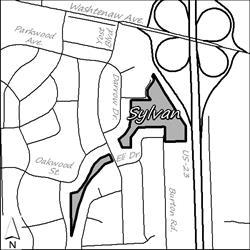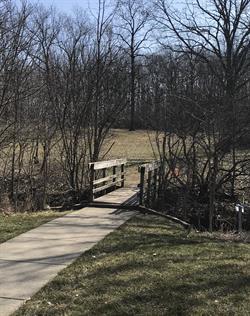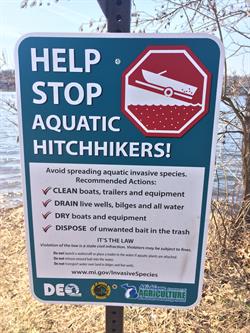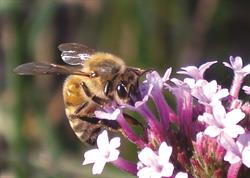Protecting and restoring Ann Arbor's natural areas and fostering an environmental ethic among its citizens.
Volume 23, Number 2
Summer 2018
Park Focus: Sylvan Park
Chris Robey, Conservation Worker
%2004.18.JPG?RenditionID=6)
Sylvan Park is a peaceful oak hickory forest next to busy US-23
Perhaps you haven't heard of Sylvan Park, but if you've ever merged onto US-23 South from Washtenaw Avenue you've almost certainly blown right past it. Tucked in Ann Arbor's southeast corner, Sylvan Park is an unassuming twelve-acre wooded area boxed in by development on all sides.
A morning spent at Sylvan Park offers a view of two seemingly opposite worlds existing atop one another. Parents emerge from their homes in the Forestbrooke subdivision to whisk the kids off to school. Commuters cram onto the highway, just a minute too late to beat the morning rush. The bustle of commerce whirs to life at the Arborland shopping center. Real estate agents, architects, contractors and other land developers coordinate to spur a nearby housing development toward realization. Meanwhile, a slower, steadier pace of life persists along Swift Run Creek and within the five-acre woodland for which the park is named.

“Sylvan" means wooded, and is used to evoke the tranquility and timelessness that we often associate with forests. Given its small size and proximity to the highway, Sylvan Park won't offer a respite so much as a reminder that even amidst the bustle and rush that characterize day-to-day urban life, there are pockets, still, where nature quietly goes its way.
At first glance, Sylvan Park is like any other city park. As you walk in, you're faced first with a tennis court, a play area with a swing set and jungle gym, and an open grassy area edging Swift Run Creek—nice, but nothing special. Then, just as you cross the small footbridge spanning Swift Run Creek, you have a feeling of déjà vu. A trickle of dimly recalled sensations cascades into moments vividly relived.
You remember the sun's warmth on your face and legs, your mud-speckled feet and the grit under your toenails. You remember wading up a creek—not this creek but one just like it—searching for minnows and tadpoles, or pausing on the bank to gather stones and arrange them in patterns. You remember dragging branches and building lean-tos where you'd retreat for spanless breadths of time. You were smaller then, closer to the ground and more attentive to its particularities– the scatter of leaves and twigs and the empty hulls of hickory nuts chewed by squirrels. You remember how once there was nowhere else you'd rather be.
It is the promise of reliving such moments, and creating them anew, that makes Sylvan Park a wonderful place to bring children, especially if it is their first up-close exposure to the natural world. The playground may hold their attention for a time. But when the creek and woods beyond call to them, lead them there. Show them what there is just beyond the ordered play of swings and jungle gyms. Bring them close to the towering trees. Let them feel their rough bark, test the difference between the different species. Share what you know. Teach them the names of things, and imagine how they're experiencing them, as you did when you were their age—for the first time.
Here is a hickory nut shell. See the teeth marks? See where he chewed through to get to the nut inside? Squirrels and other animals hide these to eat all through the winter.
This is an oak leaf. See the rounded lobes? That means its a white oak. You can also tell by the bark. It's pale and rough and scaly, like the neck of a big dragon.

The bridge over Swift Run Creek
After crossing the bridge, you will come out into an open field with picnic tables shaded by tall oaks and hickories. The specimens here are the same as the woodland's overstory—white and red oak, shagbark and bitternut hickory. The trail lies just ahead. It is a brief jaunt, at times bringing you close to the highway, but look about you and you will find yourself wandering through a historical fragment, a pocket of the oak-hickory forests that once covered the area that is now Ann Arbor. Scattered throughout you will find other characteristic species: black cherry and basswood in the overstory, sugar maple and hop-hornbeam in the subcanopy, and choke cherry, jack-in-the-pulpit, and enchanter's nightshade in the understory. Look close, and if you're lucky a drooping trillium may even grace you with an appearance.
NAP may have had an opportunity to reintroduce fire to this historic oak-hickory fragment this past spring. As with other natural areas managed by NAP, the objective of these burns is to kill woody invasives and clear out the understory to make way for native plant growth. With continued care, oak-hickory remnants like Sylvan Woods may continue to offer a buffer against day-to-day stresses for the current generation and vital first contact with the natural world for the next.
Coordinator's Corner: How Do You Turn a Nut into a Tree- Part 2
Dave Borneman, Natural Area Preservation Manager
In the last issue, I talked about the challenge that we and other land managers across the Midwest are facing regenerating our oak woodlands. We've got lots of old, large oak trees, but not so many young oak saplings ready to take their place in the future. Letting more sunlight in to the forest floor – either by cutting out dense shrubs or using controlled burns – is one way to encourage more acorns to germinate. But how do we keep those young, tender oak seedlings safe so they can grow into saplings, which will one day replace the overstory oaks? That's the focus of this article.
The conventional wisdom among researchers with the US Forest Service, trying to accomplish this same task on large tracts of public land, is this: use fire to help open up the forest floor and encourage acorn germination, then keep fire out of the forest for a number of years until those oak seedlings grow large enough (2-3 inch diameter) to withstand the heat of controlled burns. That strategy may work on large national forests, where the pressure from invasive shrubs is not nearly as great as it is here in Ann Arbor. But if we stopped burning our oak woodlands for 8-12 years, we would lose all the progress we've made in our battle against invasive buckthorn, honeysuckle, privet, and autumn olive shrubs in the past 25 years! We need fire to control the shrubs. But fire can also damage young oak seedlings. So far, our approach has been to take the long view: fire is known to benefit oaks in the long-term. Although young oaks may be sensitive to fire, they're not as sensitive as the invasive shrubs. So they'll eventually win out.
But maybe we can do better than that. Although city parks face more challenges from invasive shrubs than do the larger national forests, they do have some advantages over their larger forest cousins. The small size of our city parks, and their more intensive management, might allow us to protect individual oak seedlings. Maybe we can burn around individual oak seedlings while still burning the rest of the forest. That would allow us to continue using fire to control the invasive shrubs and keep them at bay, without also setting back the young oaks we've been trying so hard to encourage.
This spring, we started a pilot project to see if we can do just that. You may see small white flags on wire stakes scattered around some of our parks. These mark young oak seedlings that we're trying to protect from the heat of NAP's controlled burns. The protection is relatively easy: just blow the leaves away from the seedling, or wet it down with water during the burn. That should be enough to keep the young oak safe from the fire.
If this strategy works, we can hope to see more oak saplings in the forest understory in coming years. And, hopefully, these saplings will live long enough to eventually become giant oak trees for our grandchildren to enjoy.
For more information on this project, contact the NAP office.
Pollinators are in Decline- But you can Help!
Ann Arbor Pollinator Subcommittee.jpg?RenditionID=6)
Monarch Butterfly
Photo Credit: Marianne D'Angelo
Native bees, honey bees, and other pollinators are struggling because of habitat loss, disease, climate change, and the heedless use of pesticides. Creating pollinator habitat on all scales, from small spaces in your yard to larger open meadows, can have a positive impact on pollinators as well as local agriculture and economies.
Pollinators are animals, primarily butterflies and bees, which fertilize plants, resulting in the formation of seeds and the fruit surrounding seeds.
A new subcommittee of the Ann Arbor Environmental Commission, The Ann Arbor Pollinator Subcommittee, was established in 2017 with the aim of improving pollinator health. Member organizations/entities include: NAP, Leslie Science and Nature Center, National Wildlife Federation, Ann Arbor Bee City USA, Bee Safe Ann Arbor, Ann Arbor Farm and Garden Association, Ann Arbor Public Schools, Washtenaw County Water Resources Commission, University of Michigan Office of Campus Sustainability, and Washtenaw County Parks. The Pollinator Subcommittee meets monthly and is working to identify concrete actions that can be taken throughout the city, including engaging Ann Arbor residents to help. Even small steps can make a big difference.
Bee Part of the Solution!
· Plant native pollinator-friendly flowering plants. Native plants are plants that have evolved, and occur naturally in an area. Native pollinators need native plants, and vice versa. To find local sources of native plants, visit the Michigan Native Plant Producers Association website (www.mnppa.org).
· Purchase plants that have not been treated with neonicotinoid pesticides. Neonicotinoids are included in insecticides, are systemic (incorporated directly into plant cells), and are known to be toxic to pollinators. Ask your retailer/grower if seeds or plants have been pre-treated with these chemicals.
· Use non-toxic gardening methods on food and ornamental plants and trees. Herbicides can reduce the food pollinators need for larvae and adults. Fungicides can also be toxic to pollinators. If you see some holes in plant leaves, that may be a good sign of caterpillar foraging. Watch for the next stages of caterpillars and chrysalis on plants, followed by butterflies! Stop and think before you spray anything outdoors.
· Reduce lawn mowing to every 2 to 3 weeks and leave some areas free of mulch for ground nesting pollinators. Add variety to your lawn! Turf grass is poor habitat for pollinators. Better yet, turn your lawn into a wildflower meadow.
· Encourage your landlord or homeowners association to create pollinator-friendly habitats and maintenance policies.
· Install a pollinator-friendly rain garden that both reduces runoff and attracts pollinators.
· Put up a native bee hotel or house in your yard.
For more resources and information, visit the Ann Arbor Pollinator Subcommittee page: www.a2gov.org/pollinators.
NAPpenings
Thank you!
Many thanks to the groups who volunteered with NAP recently. We could not make such a difference without you!
Alpha Phi Omega, UM
Alpha Phi Omega – Lambda Phi Chapter, EMU
Alpha Sigma Mu, UM
Ann Arbor Open
Ann Arbor Running Fit
Ann Arbor Spartans
Circle K, UM
Community High School
Ecological Issues, UM
Greenhills School
School for Environmental and Sustainability, UM
Skyline Environmental Club
Tau Beta Sigma, UM
UM Bands
YMCA, Plymouth
You Beautiful Black Woman
Youth for Understanding
Youth Volunteer Corps
Tri-colored Bats in Ann Arbor
We have the results from the bat survey we conducted last summer with the Organization for Bat Conservation. We recorded calls from 5 species of bats along our route in Ann Arbor, including 1 call of a little brown bat and 3 calls of tri-colored bats, both of which are species of special concern. This is exciting because this is one of only a few times anyone has ever documented tri-colored bats in Michigan in the summer! You can help bats in Ann Arbor by planting native plants and putting up bat boxes.
It's Turtle Nesting Season
In our area, May and June is turtle nesting season! Please keep an eye out for turtles laying eggs in our parks this time of year, and let us know when and where you see them so we can protect their nests. Female turtles dig a hole with their hind legs, lay their eggs, then cover the nest and return to the water.
New Signs at Dolph, Argo, and Gallup Parks
 Going off of a tip from a park user, the DEQ Aquatic Invasive Plant Response Team, working with NAP, removed 60 lbs. of the Watch List species, Water lettuce (Pistia stratiotes), from First Sister Lake last fall. Water lettuce is commonly used in backyard ponds and water features. Given that, there is a high probability that this plant was dumped into First Sister Lake. In an effort to stop the movement of invasive species, park users will find new signs at First and Second Sister Lakes, Gallup and Argo parks reminding people to stop aquatic hitchhikers.
Going off of a tip from a park user, the DEQ Aquatic Invasive Plant Response Team, working with NAP, removed 60 lbs. of the Watch List species, Water lettuce (Pistia stratiotes), from First Sister Lake last fall. Water lettuce is commonly used in backyard ponds and water features. Given that, there is a high probability that this plant was dumped into First Sister Lake. In an effort to stop the movement of invasive species, park users will find new signs at First and Second Sister Lakes, Gallup and Argo parks reminding people to stop aquatic hitchhikers.
Staff Updates
Farewell
 Katie Carlisle, Park Steward Coordinator
Katie Carlisle, Park Steward Coordinator
It's been such a pleasure working with Natural Area Preservation the past couple years! I have enjoyed getting to know all the Park Stewards and other volunteers. From walks in the park to pulling garlic mustard, it's been a lot of fun. I'm excited to take the knowledge and experience I've gained on to my new position with Washtenaw County Parks and Recreation. I look forward to continuing to see you all around Ann Arbor and Washtenaw County!
Welcome
 Chris Robey, Field Crew
Chris Robey, Field Crew
As a recent transplant from North Carolina, I'm eager to come to know Ann Arbor's natural areas as a member of NAP's conservation crew. Connecting people to places through stewardship and storytelling lies at the heart of what I do. I graduated from Appalachian State University with an Environmental Humanities degree and minors in English and Sustainable Development. I've written articles for the Appalachian Voice, worked on and led trail crews for Southern Appalachian Wilderness Stewards, and learned the ropes (quite literally!) as a groundsman for a local arborist. Now, I am thrilled to join NAP's staff and our wonderful volunteers as we work to fulfill our mission.
 Meija Knafl, Park Steward Coordinator
Meija Knafl, Park Steward Coordinator
A recent graduate from the University of Maine's wildlife ecology program, I am incredibly excited to be joining the NAP team! Born and bred in Ann Arbor, it's a dream come true that I've been given the opportunity to bring my passion for the outdoors home. I've spent several summers as a seasonal naturalist for the MDNR leading groups of children in nature-based outdoor programming. These summers have further fueled my drive to create opportunities for people to involve themselves with the nature that surrounds them every day. I'm looking forward to working with Park Stewards and other independent volunteers, connecting people with our wonderful wild spaces in meaningful ways.
Would you like to be part of the NAP Staff team? Follow the city jobs website (a2gov.org/jobs). Positions can open throughout the year.
NAP also has unpaid internships that provide valuable experience! For internship information contact NAP directly: [email protected] or 734.794.6627.
Ann Arbor is Helping Pollinators
Becky Gajewski, Stewardship Specialist

Photo Credit: Therese Roth
Did you know that the City of Ann Arbor has joined several national initiatives to help protect and restore pollinator habitat? A newly-formed Pollinator Subcommittee of the Environmental Commission is working hard to ensure Ann Arbor is a friendly place for bees, birds, and butterflies, both today and into the future. NAP and our volunteers play a huge role in carrying out the objectives of these initiatives by actively restoring and enhancing the natural communities pollinators call home, and by getting the word out about the importance of these hard-working species.
Learn more about each initiative below.
· Mayor's Monarch Pledge – Mayor Taylor has committed to specific action items to increase pollinator habitat and celebrate monarchs. Check out www.nwf.org/mayorsmonarchpledge
· Bee City USA – City officials and community members are working together to spread the word about the importance of bees and to increase bee habitat in private yards and parks. Check out www.beecityusa.org
· National Wildlife Federation Community Wildlife Habitat – Ann Arbor and Washtenaw County are recognized for providing habitat for and raising awareness about wildlife throughout our communities. Check out www.nwf.org/community
· National Fish and Wildlife Foundation Monarch Fund – Coming soon! NAP will be adding additional native seeds to several prairie habitats in our parks to make more diverse habitats for monarchs. Check out www.nfwf.org/monarch
· Ann Arbor Pollinator Subcommitte– Read more about their efforts on page 3 and www.a2gov.org/pollinators
